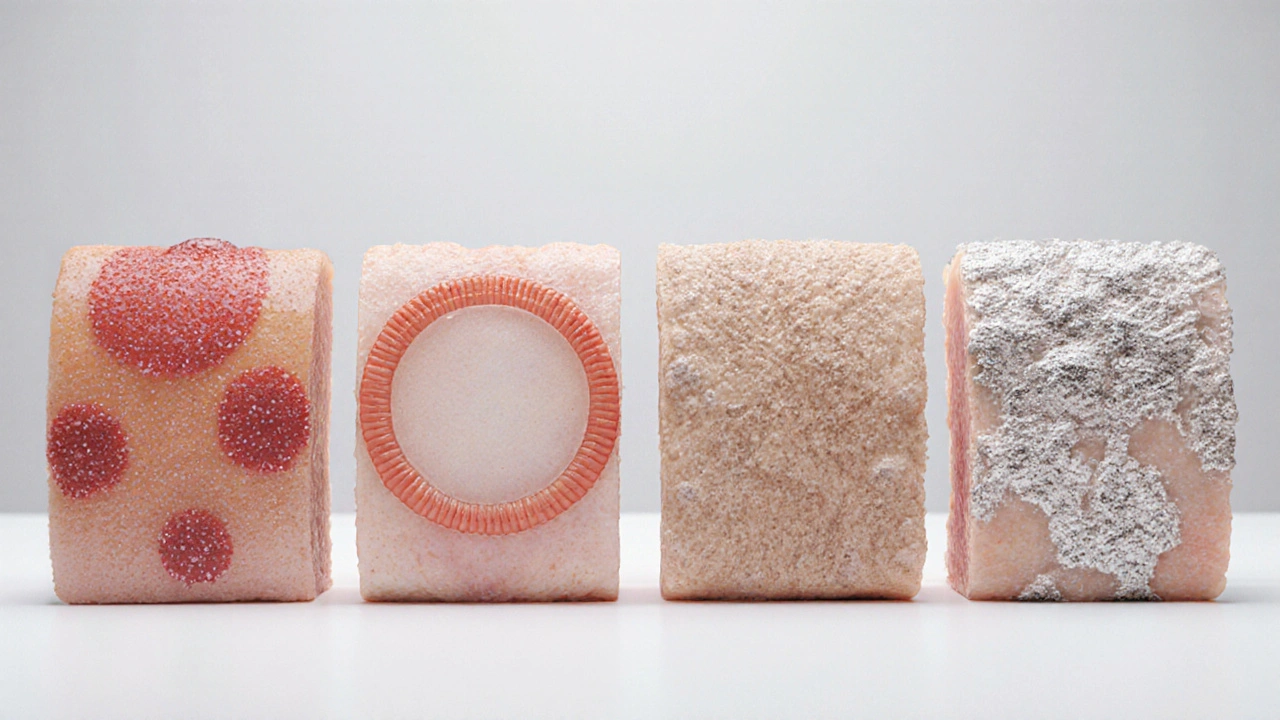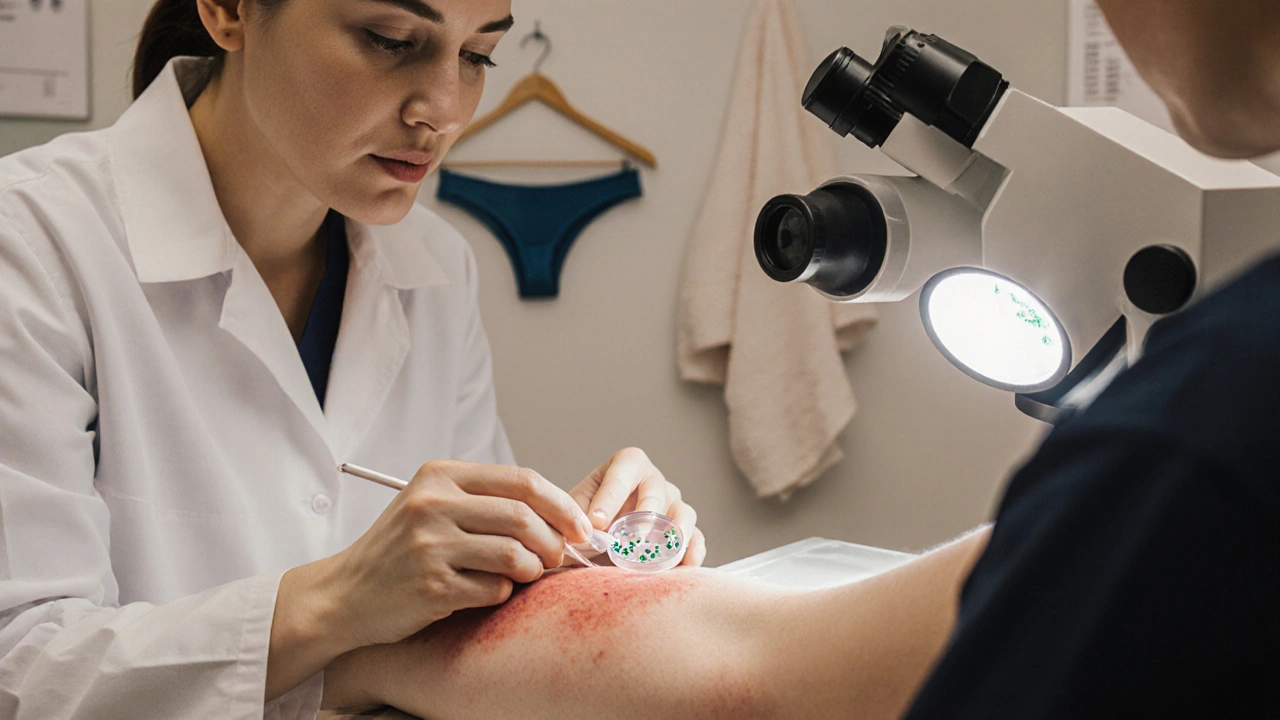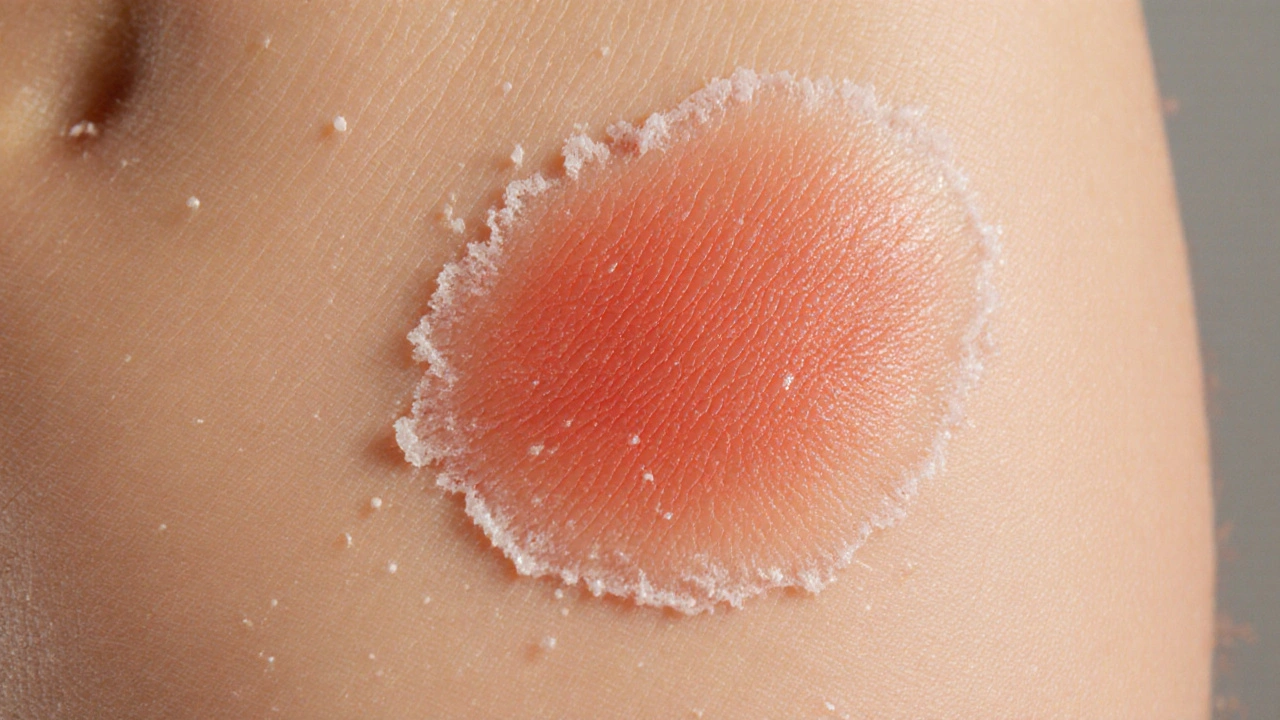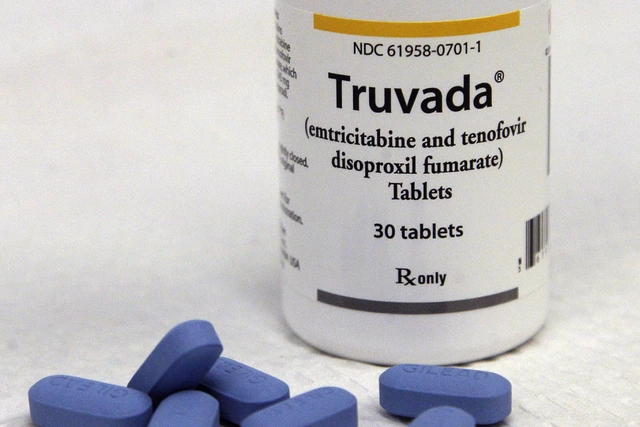Skin Rash Symptom Checker
This tool helps you assess whether your rash is likely a yeast infection or another common skin condition. Answer the questions below to determine the most probable cause of your symptoms.
Location:
Is your rash primarily in warm, moist areas like your groin, under breasts, or armpits?
Texture:
Does your rash appear red, moist, or satiny with possible white scaling at the edges or satellite lesions?
Itch Intensity:
Is your itch intense with a burning sensation, especially worse after sweating?
Triggers:
Have you recently used antibiotics, have diabetes, or been wearing tight clothing?
Response to Treatment:
Has your rash improved with over-the-counter antifungal creams?
Result Analysis
Key indicators:
When a patch of skin suddenly turns red, itchy, or flaky, it’s easy to assume it’s just a harmless irritation. But not all rashes are created equal-some are caused by a yeast overgrowth that needs specific treatment. This guide walks you through the tell‑tale signs of a skin yeast infection, how it differs from common skin disorders, and what steps to take next.
What a Skin Yeast Infection Looks Like
In medical terms, a skin yeast infection is called cutaneous candidiasis - a fungal infection caused primarily by Candida albicansa type of yeast that normally lives on the skin and in mucous membranes without causing trouble. When the balance tips, Candida multiplies and produces a rash that typically has the following features:
- Bright red, well‑defined patches that may merge into larger areas.
- Intense itching that can feel like a burning sting.
- Fine white or creamy scaling at the edges, sometimes described as “satiny”.
- Moist, sometimes macerated skin in folds (under the breasts, groin, armpits).
- Occasional tiny pustules or satellite lesions that spread outward.
The rash often thrives in warm, damp environments-think sweaty gyms, tight underwear, or after prolonged exposure to water.
Common Skin Conditions That Look Similar
Many non‑fungal skin problems share overlapping symptoms. Knowing the key differences saves you from months of trial‑and‑error topical creams.
| Condition | Typical Appearance | Itch Intensity | Common Triggers |
|---|---|---|---|
| Cutaneous candidiasis | Red, moist, satiny patches; satellite lesions | Severe | Humidity, antibiotics, diabetes, tight clothing |
| Tinea corporis (ringworm) | Ring‑shaped, raised border with clear centre | Moderate | Contact with infected pets, soil, shared towels |
| Eczema (atopic dermatitis) | Dry, scaly patches; often on flexural areas | Variable, often chronic | Allergens, stress, skin barrier defects |
| Psoriasis | Thick, silvery‑white plaques with well‑defined edges | Usually mild | Genetics, immune triggers, alcohol |
| Cellulitis (bacterial infection) | Diffuse redness, swelling, warmth; may have fever | Low to moderate | Breaks in skin, poor circulation, diabetes |
Notice how the yeast infection’s hallmark is moisture and satellite lesions-features you won’t see with dry conditions like eczema or the classic ring shape of tinea.

How Professionals Confirm a Yeast Rash
Self‑diagnosis is tempting, but a quick office visit can spare you weeks of ineffective treatment. Doctors usually follow a three‑step approach:
- Visual exam: The clinician checks location, colour, and texture.
- Skin scraping: A small amount of skin cells is gently scraped from the edge of the rash.
- Microscopic test (KOH test): The sample is mixed with potassium hydroxide, which dissolves skin cells and leaves fungal elements visible under a microscope. This is called the KOH testa rapid, low‑cost method to detect Candida and other fungi in skin samples.
If the KOH test shows budding yeast or pseudohyphae, the diagnosis is confirmed. In ambiguous cases, a culture may be sent to a lab for species identification.
Treatment Options You Can Expect
Once the diagnosis is clear, treatment targets the fungus directly. The two main routes are topical and oral antifungals.
- Topical antifungal creams: Over‑the‑counter options like clotrimazole, miconazole, or terbinafine are often enough for mild cases. Apply a thin layer twice daily for 2‑4 weeks, even if the rash clears sooner.
- Prescription creams: For stubborn or extensive infections, stronger agents such as ketoconazole or ciclopirox may be prescribed.
- Oral antifungal pills: In severe, recurring, or deep‑seated infections, doctors may use fluconazole or itraconazole for a short course (usually 1‑2 weeks).
Regardless of the medication, the key is consistency-stopping treatment early lets the yeast rebound.
When to Seek Professional Help
Not every red patch requires a doctor, but watch for these red‑flags:
- Fever, chills, or feeling generally unwell.
- Rapid spread beyond typical flexural zones.
- Painful swelling, especially if the area feels hot to touch.
- Rash that doesn’t improve after a week of over‑the‑counter antifungal cream.
- Underlying conditions such as diabetes, immune suppression, or recent antibiotic use.
If any of these appear, schedule a visit. Early intervention prevents deeper tissue involvement and reduces the chance of recurrence.

Preventing Future Yeast Outbreaks
Yeast loves moisture, so the best defense is dryness and barrier protection.
- Keep skin dry: After showering, pat-not rub-areas like the groin and underarms. Use talc‑free powder if needed.
- Choose breathable fabrics: Cotton or moisture‑wicking blends beat synthetic polyester for underwear and sports gear.
- Avoid prolonged occlusion: Change out of sweaty gym clothes within an hour.
- Watch your diet: High‑sugar diets can feed Candida; aim for balanced meals with plenty of veggies.
- Limit unnecessary antibiotics: Only take them when prescribed, as they disturb the skin’s natural microbiome.
- Maintain good foot hygiene: Fungal infections often start on the feet and spread to other areas.
These habits cut the odds of a repeat infection dramatically-studies show a 30‑40% reduction when patients adopt a dry‑skin routine.
Quick Checklist: Is It a Yeast Infection?
- Location: Warm, moist folds or skin‑to‑skin contact zones?
- Texture: Satiny, red, with possible white scaling or satellite spots?
- Itch: Burning, persistent, worse after sweating?
- Triggers: Recent antibiotics, diabetes, tight clothing?
- Response to OTC antifungal: Improves within 3‑5 days?
If you answered “yes” to most of these, a yeast infection is likely. Still, a brief clinic visit can confirm and set you on the right treatment path.
Frequently Asked Questions
Can a skin yeast infection turn into a serious condition?
In healthy individuals, cutaneous candidiasis stays superficial. However, if it spreads to deeper layers or enters the bloodstream-especially in immunocompromised patients-it can become serious. Prompt treatment and good hygiene keep it from escalating.
How long does it take for an over‑the‑counter cream to work?
Most people notice reduced itching within 2‑3 days, but the rash usually needs 2‑4 weeks of consistent application to fully clear. Stop using the cream only after the skin looks normal for several days.
Is a yeast infection contagious?
Skin‑to‑skin transmission is rare. The infection usually results from an overgrowth of a yeast already present on the skin. However, sharing towels or clothing that stay damp can spread the fungus to another person’s skin folds.
Why does my rash flare up after I finish a course of antibiotics?
Antibiotics kill beneficial bacteria that normally keep Candida in check. With that competition gone, yeast can multiply, leading to a flare‑up. Probiotic‑rich foods or a short antifungal regimen can help balance the flora.
Can home remedies replace medical treatment?
Some people find relief with tea tree oil, yogurt, or apple cider vinegar, but evidence is limited. For persistent or extensive rashes, proven antifungal medications are far more reliable.




anshu vijaywergiya
October 12, 2025 AT 13:09Imagine the fury of a summer storm trapped on your skin, each itch a lightning strike that refuses to quit.
When the groin folds become a swamp, the red patches bloom like malicious roses, and the burning sensation feels like tiny dragons dancing across the nerves.
That, dear reader, is the classic sign of cutaneous candidiasis, a yeast that has decided to throw a party where it doesn’t belong.
First, locate the battlefield: warm, moist valleys like under the breasts, in the armpits, or the inner thighs.
Second, observe the enemy’s uniform: satiny, red, sometimes with white scalloped edges that look like delicate lace‑work gone rogue.
Third, feel the intensity of the assault – a burning itch that intensifies after a sweaty workout or a hot shower.
Fourth, recall recent betrayals by antibiotics, diabetes, or clothing that clings tighter than a vice.
Fifth, test the defenses by applying an over‑the‑counter antifungal; if relief appears in a few days, you’ve likely hit the jackpot.
But beware the impostors – eczema’s dry scaly armor, psoriasis’s thick silvery plaques, and the ringworm’s perfect halo.
Each masquerades differently: eczema loves the bends, psoriasis flaunts its plaques, and ringworm draws a perfect circle with a clear center.
When in doubt, a quick visit to a clinician can save weeks of trial‑and‑error, where a simple KOH test will reveal the budding yeasts under the microscope.
Topical creams like clotrimazole or miconazole are the frontline soldiers; apply twice daily for two to four weeks, even after the rash seems gone.
For stubborn invasions, prescription creams or a short course of oral fluconazole may be your heavy artillery.
And remember, victory is sealed by keeping the terrain dry: pat the folds, wear breathable fabrics, and change out of sweaty gear promptly.
Finally, a balanced diet low in sugar and judicious use of antibiotics will keep the yeast from staging future uprisings.
Stay vigilant, stay dry, and let your skin breathe – the kingdom will thank you.
ADam Hargrave
October 18, 2025 AT 18:06Oh great, another “DIY skin guide” because who needs doctors when you have the internet, right? 😏
Rohit Poroli
October 25, 2025 AT 16:46From a dermatological standpoint, the pathophysiology involves an overgrowth of Candida albicans facilitated by disrupted epidermal barrier function and altered microbiome equilibrium, often precipitated by hyperglycemic states or broad‑spectrum antibiotic therapy. The resultant erythematous macules exhibit a characteristic satiny sheen due to superficial desquamation, and the pruritus is mediated by histamine release from mast cells localized in the stratum corneum. Clinical differentiation hinges on the presence of satellite papules extending peripherally, as opposed to the annular morphology observed in tinea corporis. Diagnostic confirmation typically employs a potassium hydroxide (KOH) preparation, wherein pseudohyphae become discernible under light microscopy, providing rapid, cost‑effective verification. Therapeutic regimens prioritize azole class agents-clotrimazole 1% or miconazole 2%-applied bid for a minimum of 14 days, with systemic fluconazole reserved for refractory or extensive involvement.
Jessica Tang
November 1, 2025 AT 15:26For most mild cases, a twice‑daily application of an over‑the‑counter azole cream for three to four weeks is sufficient; just be sure to continue the regimen for a few days after the rash disappears to prevent recurrence.
Matt Quirie
November 8, 2025 AT 14:06The presentation of cutaneous candidiasis typically includes well‑demarcated, erythematous patches, often accompanied by a moist, satiny surface; however, differential diagnosis must consider conditions such as eczema, psoriasis, and bacterial cellulitis, each of which exhibits distinct morphological features; therefore, a thorough clinical evaluation, supplemented by a KOH microscopy test when appropriate, is strongly recommended; subsequent management should involve topical antifungal agents, and in severe or recalcitrant cases, systemic therapy may be warranted.
Pat Davis
November 15, 2025 AT 12:46It is noteworthy that in many South Asian communities, traditional dress and climatic humidity create an environment conducive to cutaneous candidiasis, making public health education on proper hygiene and breathable fabrics especially pertinent.
Mary Wrobel
November 22, 2025 AT 11:26Think of your skin like a garden-give it sunlight, loose soil, and the occasional water, but don’t let it drown, and the pesky weeds will have a hard time taking root.
Lauren Ulm
November 29, 2025 AT 10:06They don’t tell you this, but some of the “over‑the‑counter” creams are actually engineered to keep you buying more-yes, the big pharma hive mind wants a constant supply of fungus to sell their next‑gen formulas 🤖🕵️♀️.
Michael Mendelson
December 6, 2025 AT 08:46Honestly, if you’re still slappin’ on random ointments without a clue, you’re just feeding the fungus a weird buffet of chemicals-gotta be smarter than that.